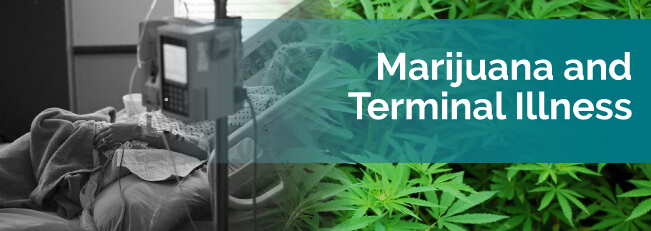
People who have been diagnosed with a terminal illness suffer a broad range of physical and emotional symptoms and other overwhelming struggles. Terminal illnesses are devastating diagnoses, and patients must learn to cope with the news that their disease cannot be cured.
When it comes to terminal illnesses, conventional medicine focuses on palliative treatment goals. This means doctors aim to make their patients feel as comfortable as possible in their last remaining weeks or months. Unfortunately, most of the drugs prescribed to terminally ill patients cause a host of unpleasant side effects, and some people flat out stop responding to conventional treatments. That’s where natural therapies come into play.
Medical cannabis is an excellent option as a complementary treatment solution alongside prescription opiates or other drugs for symptom management, but it can also be an effective alternate solution when patients suffer from side effects and no longer wish to take conventional medications.
Studies on medical cannabis and terminal illness have proven its effectiveness in treating specific symptoms that are often associated with end-of-life difficulties. Medical cannabis is a safe remedy for maintaining quality of life and providing comfort and relief for patients with terminal illnesses.
Terminal illness is a broad term used to describe any kind of illness that is incurable or untreatable. Patients with a terminal illness have been told by their medical team that they have a certain remaining life expectancy and their disease will likely result in death. Illnesses like AIDS or cancer can be diagnosed as terminal illnesses when the disease is too advanced to be treated.
One of the primary issues surrounding a terminal illness is the psychological trauma associated with the diagnosis. Many patients fall into a deep depression and may even turn to substance abuse. Additionally, many of these patients have such advanced illnesses that they suffer from chronic pain, which only further amplifies their psychological symptoms.
Sadly, terminal illnesses affect far too many families. In 2006, the Pew Research Center reported that 42% of Americans know a friend or relative who is suffering or has suffered a terminal illness. Though this is a shocking statistic, but it’s made clearer when looking at the rates of terminal illnesses among Americans.
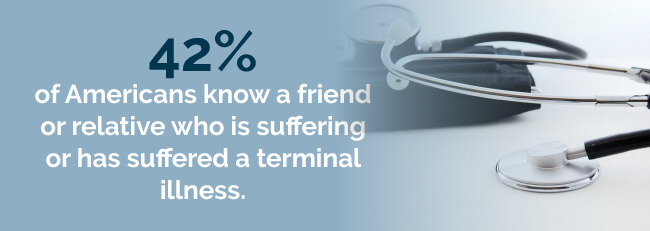
In the United States, cancer is the second leading cause of death. On average, more than 1,500 Americans die each day from cancer. HIV/AIDS is another potentially terminal illness taking far too many lives. In 2014, 6,721 Americans died from HIV or its complications, although the death rate associated with AIDS is steadily declining in the United States.
An under-recognized potentially terminal illness in the United States is kidney disease. According to the National Institutes of Health, advanced kidney failure kills more Americans than breast or prostate cancers. In 2013, 47,000 Americans died of kidney disease.
Terminal illness doesn’t just affect adults and seniors. The National Cancer Institute reported that in 2014, 1,960 children and adolescents under the age of 19 died from cancer.
With these high rates of terminal illness in American society, it’s no wonder many of these patients are turning to medical cannabis as a natural end-of-life therapy.
The landscape of illnesses has changed drastically in the past 100 years. Thanks to greater global disease awareness and advanced medical technologies, people are living longer than ever. But illnesses themselves have evolved. A hundred years ago, it was common for people to die from infections and other acute conditions that could not be treated medically.
Today, in the industrialized world, it’s less common for people to die from infections. However, chronic illnesses attributed to our environment, lifestyles and the fact that people are living longer are the new medical challenge our society faces. Generally, our high-fat diets, sedentary lifestyles and increased exposure to synthetic products and chemicals have led to new types of terminal illnesses to combat. Cancer is a potentially fatal disease that is claiming lives at an astonishing rate.
In 2003, the World Health Organization, recognizing the global cancer epidemic, published a report estimating that by 2020, cancer death rates would increase by 50% to 15 million annually.
Thankfully, since those findings were published, medical technology has advanced, and many of these expected deaths are now preventable. There are still far too many cases where cancer results in terminal illness. This is why different therapy approaches, such as medical cannabis, can help address the cases where cancer becomes fatal.
There are many different types of terminal illnesses all resulting from different causes and risk factors. Here are some of the terminal illnesses patients are diagnosed with as well as their causes:
All cancers are terminal if left untreated. Some cancer types are deadlier than others. Two of the deadliest forms of cancer are brain and ovarian cancers. The National Cancer Institute estimates that 16,700 Americans will die of brain cancer and 14,080 will die from ovarian cancer in 2017.
These conditions are some of the many well-known terminal illnesses that exist. Countless other diseases and conditions are considered terminal when patients stop responding to treatments or when the illness becomes too advanced to treat.
While there are many different conditions that cause terminal illnesses, each having their own unique symptoms, most patients experience a similar set of symptoms during the end stages of life. These common symptoms include both physical and emotional or mental symptoms.
Here are the common symptoms experienced by people with terminal illness:
Physical Symptoms. When patients suffer advanced stages of diseases, there are common physical symptoms that occur. These symptoms include chronic pain and general weakness. Chronic pain affects more than 60% of cancer and AIDS patients. Other physical symptoms of terminal illness include:
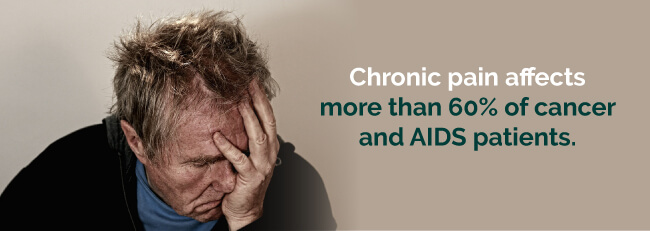
Emotional Symptoms: A terminal illness diagnosis is tragic and earth-shattering for patients and their families. Because of this, there is a range of different reactions among patients. Patients can experience emotions such as:
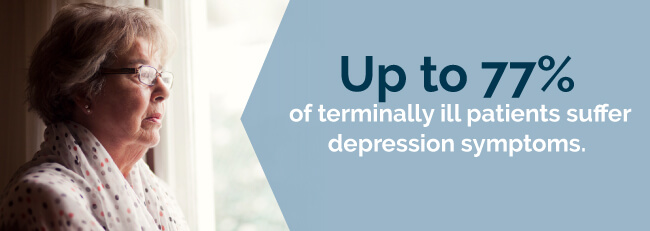
Many patients diagnosed with terminal illness go on to develop depression and anxiety. The Baylor University Medical Center found up to 77% of terminally ill patients suffer depression symptoms. Other reports indicate up to 20% of terminally ill patients are diagnosed with major depression — a serious and chronic grade of depression. In many cases, anxiety and delirium also accompany feelings of depression.
Treatments for terminal illness are focused on improving a patient’s comfort and quality of life in their remaining time. Terminal illnesses, however, are untreatable in the sense that they cannot be cured. Terminal illness treatments are referred to as palliative, meaning they reduce pain without an attempt to cure the disease.
Treatments focus on alleviating pain, improving strength and appetite and managing any symptoms of depression, anxiety and grief.
Here are the types of conventional treatments and care given to patients with terminal illness:
Unfortunately, many patients with terminal illnesses struggle with the types of palliative treatments they’re prescribed. Opiates and antidepressants both come with a host of side effects that can aggravate many of the end-stage struggles people experience. Medical cannabis is an alternative or complementary treatment option that many people with terminal illnesses have had success with.
The cannabis plant contains two organic compounds that provide medical benefits: tetrahydrocannabinol (THC) and cannabidiol (CBD). THC is the compound responsible for the psychoactive effect associated with cannabis. It’s also shown to possibly reduce pain, relieve nausea and boost appetite.
CDB is the other compound that doesn’t produce psychoactive effects. However, it does treat symptoms like pain, nausea, depression and anxiety, which are all associated with terminal illness.
Legal medical marijuana such as Marinol is approved by the FDA. In some states, smoked marijuana is also legal under state law but still illegal under federal law. Both forms of medical marijuana have been shown to help with pain. They are not pain relievers, but can work with opiates to make them more effective.
According to UCSF, they conducted a study using cannabinoids with opiates and found that patients showed up to 95% decrease in chronic pain when using inhaled marijuana vapor with opiates such as morphine. It also showed that the dosages of opiates could be decreased when opiates are used in conjunction with cannabinoids.
One of the strongest arguments for medical marijuana and terminal illness is for the treatment of nausea, vomiting and loss of appetite. Cancer patients that are undergoing chemotherapy have benefited greatly from the availability of FDA approved medical marijuana. It is known to reduce nausea and vomiting, often when more traditional medical treatments for the symptoms fail to produce significant results. Nausea and Vomiting can occur with several terminal illnesses such as cancer and AIDS – related illness.
Cancer and AIDS can also result in loss of appetite. It is expected at the very end of life that appetite decreases until it is nonexistent in many cases. However, it is often good for patients to eat as much as possible until it becomes impossible. Medical marijuana can help with that and is prescribed for just such occasions. In fact, the hunger-inducing effects of medical marijuana are so well known that they are even known colloquially as “the munchies” in the recreational marijuana use community.
Medical marijuana’s effects are felt soon after ingestion and virtually immediately after inhalation. There is no waiting period as there is for antidepressants. There is no guarantee that it will alleviate depression, stress and suicidal thoughts. However, it is useful for its fast-acting benefits. There is some research to suggest that medical marijuana can help some of the symptoms associated with depression, particularly difficulty sleeping, but it is still an under-researched area of medical care.
Medical cannabis a versatile and natural therapy for people diagnosed with a terminal illness. The diverse health benefits of the cannabis plant address many of the common symptoms terminally ill patients face.
Here are some of the best strains of medical cannabis for terminal illness and the symptoms these strains treat:
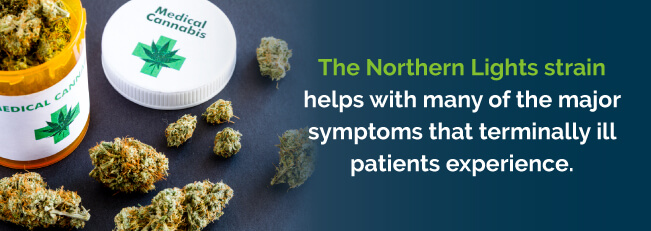
There are countless different strains that can offer relief for terminal illness symptoms. Be sure to consult your local dispensary experts for more information on choosing the right strain for you.
If you’re planning to use medicinal marijuana to treat your terminal illness symptoms, then it’s important to decide how you’ll consume it. You have a few different options. Here are some of the options for consuming medical cannabis for terminal illness:
Medical marijuana for terminal illness is generally very safe to use. There are limited side effects for most people who consume medicinal cannabis products. Some patients who are suffering major depression because of their terminal illness diagnosis may be concerned that marijuana products may heighten their depression symptoms. However, there is no research to suggest that prescribed medical marijuana can harm the terminally ill.
Additionally, marijuana does not interact negatively with other end-of-life treatments. No amount of it will result in fatal overdose. Further research is necessary to see if these trends in medical marijuana use hold true. However, its use for terminal illness is promising thus far.
If you’re planning to take medical cannabis for terminal illness symptoms, it’s important to follow the dosage instructions exactly as prescribed. For many people, the effects of marijuana make take a while to kick in. This is why it’s important to start with a small dose and gradually build from there.
Medical cannabis is a safe, alternative remedy for treating many of the terrible symptoms associated with terminal illness. If you or someone you love has been diagnosed with a terminal illness and would like to learn more about medical cannabis as an alternative treatment option, make an appointment with a local, qualified physician through MarijuanaDoctors.com today or sign up for our newsletter.
For more information about how cannabis can be used to treat Terminal Illness, check out our resources:
Find A Doctor Find A Dispensary